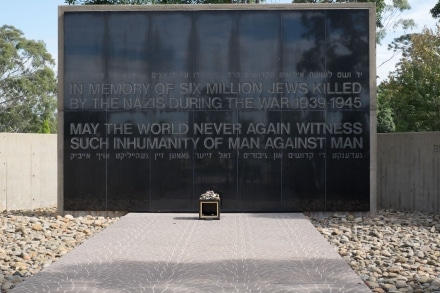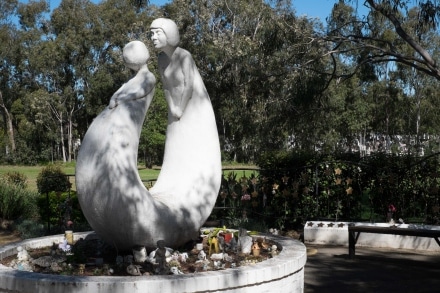When Mark Bundy applied for a grave digging job at Sydney’s Rookwood Cemetery, he was asked three questions. “Are you married?”, “Do you have children?” and “Do you have a mortgage?”. After answering “Yes” to all three, he was told “You start on Monday”. That was over 25 years ago.
No longer called a grave digger his profession nowadays is known as a burial or funeral technician. Today I join him on his first Historical tour of Rookwood since the COVID lockdown.

There have been changes to how the tour is run. Instead of piling into a minibus, participants socially distance and drive themselves around this vast cemetery, slowly following Mark’s ute in a fashion not dissimilar to a funeral procession.
We meet in the All Souls Chapel. Two heavy wooden doors either side of the arched leadlight window can close off the window during non-religious ceremonies. People from over 90 different religious and cultural groups are buried in Rookwood, all with their own rituals and customs.

I learn that Jewish coffins are plain, free from metal and have rope handles. And that a Muslim funeral director removes the suitably wrapped deceased from the coffin and places the body in the grave on its side, facing Mecca.
Near All Souls Chapel three graves with shiny black headstones serve as training graves. Here apprentice grave diggers learn how to safely lower coffins into the ground.
Rookwood is one of the oldest working cemeteries in Australia and the largest in the southern hemisphere. Consecrated in 1867, the location for the necropolis was chosen because of its proximity to the Sydney to Parramatta railway line.

A twice daily train service carried corpses at no charge and mourners, who paid one shilling each, from the mortuary station near Central Station to Rookwood. Mark leads our procession of cars to “receiving house number one”, the largest of the four Rookwood Stations.
The footings, all that remains of this decorative sandstone station are “a testament to the start of Rookwood” explains Mark. The decorative sandstone building is now in Canberra. It was dismantled brick by brick, transported in 83 semi-trailers and rebuilt to become the All Saints Church of England in Ainslie.
Death is a sad and serious business, but Mark injects humour and interesting anecdotes into the tour. Yes, we squirm at some of what he tells us about the realities of what happens after burial, but we also laugh and chuckle and are fascinated by the stories.
The origin of the word wake can be traced back to when mourners held a party at the graveside keeping watch to see if the deceased would wake. A string might be tied to the deceased’s finger, passed through a hole drilled into the lid of the coffin. Should they wake up, they could ring a bell at the end of the string to attract the attention of the person doing the “graveyard shift” ie keeping watch overnight.

We walk across to the Chinese section of the cemetery and the Quong Sing Tong Temple which Mark says was built in a classical European style so as “not to offend the nearby Presbyterian mourners”. Of course, this was back in 1877.
The smaller and obviously Chinese metal structure was where mourners burnt paper money and let off fire crackers to honour the dead and ensure they had a rich afterlife.
Standing in the warm sun, Mark points out the grave of colonial architect James Barnet, who designed many Sydney buildings including the GPO. Other well-known Australians buried in Rookwood include retailer David Jones, publisher John Fairfax, ex-Premier of NSW Jack Lang and businessman and merchant Mei Quong Tart.

Headstones range from simple white crosses to symbolic gravestones. Mark explains that a broken column symbolizes “a life cut short”, while a draped urn represents “the ashes of life”. One elaborate vault in the shape of St Mary’s Cathedral houses John Watson who loved the cathedral and whose name is carved into the flowers above the doorway.
Without Mark’s expertise and knowledge, we wouldn’t know about James Ross Logan, a tram driver who died when the motor fell on him. A steam tram number 37 carved into his headstone reflects his profession and how he died.

Black crows (rooks) fly across the clear blue sky squawking loudly. One story claims that Rookwood was named after them. We stop to listen and observe our surroundings. Apart from birds chirping in the trees, there’s a peaceful silence echoing Rookwood’s motto to Respect Reflect and Remember.
Yellow wattle flowers brighten up the scene and a native vine with tiny purple flowers winds its way along the ground around tombstones. This is a place for reflection and contemplation.
More symbolism is evident in the Martyr’s Memorial designed by Harry Seidler. Remembering Holocaust victims, the black granite and cobblestones represent the buildings and streets of Europe. Jews place stones on graves as opposed to flowers as stones remain forever while flowers die.

Our group becomes still and sombre as we look out across the green neatly mown Baby Lawn. Thirty thousand babies rest here. Beyond the lawn is the Circle of Love where babies and children whose lives were cut short are remembered.
Mark points to a child’s face amongst the many children’s faces on a brass plaque. Pictures of his child and children of other grave diggers were used to remember the babies and children in unmarked graves across the cemetery.

On a lighter note, Mark tells us that an urn need not cost as much as a funeral. Any container “even a beer bottle” will do. One woman wanted an egg-timer for her husband “so the bugger keeps working”.
As Mark says “After working here, nothing surprises me.”

Rookwood Cemetery is vast. A two-hour tour only scratches the surface of the history residing in this sleeping city. It also answers questions we are often too afraid to ask about what happens to the bodies of loved ones.
If you prefer to explore independently, have a look at this post which explores Rookwood as well as neighbouring Lidcombe
Useful Information
- Tours of Rookwood Cemetery are Free
- You can attend one of the scheduled tours or arrange one for your own group from Monday to Friday
- COVID restrictions require guests to drive themselves and maintain social distancing
- Volunteer Friends of Rookwood also run monthly tours, each with a different theme. The $15 cost per person goes towards preservation funds. See this link for more information
- Rookwood Cemetery is vast. You really do need a car
- The Rookwood Hidden Sculpture exhibition will return in 2021
- Click this link for maps and directions

Comments
Great article Joanne. The cemetary is also a fascinating place to ride a bike as you see a lot more of this vast estate. I covered it on one of my blog rides at https://ebikerdiary.com/2019/01/31/botany-to-rookwood/
Thanks Richard. I’ll take a look at your post.
Enjoyed and admire your writing, as usual! You can even make a cemetery inviting!!!
Thanks Nancy. It’s a fascinating tour.
Love a good cemetery. The St Mary’s Cathedral vault is incredible.
Yes, Erica, it’s always interesting discovering a ‘sleeping city’. So much hidden history.
Such an interesting article Jo, funny and informative. Who would think that you need to train for a grave digger job, but on the other hand, it would be horrible for things to go wrong in such a situation?
I’m pleased you liked it, Bernadette. Your comment about things going wrong made me chuckle.
A very interesting read Joanne, didn’t realise the different customs in burials.
Thanks Christine. It’s fascinating to learn more about various customs and cultures, isn’t it?
Hi Jo,
We went Tuesday with the Institute of Australian Tour guides ! Mark is certainly an
outstanding character and made it so much more interesting. I felt like I was in Europe at a famous ancient cemetery. Especially surprising to me was the Harry Seidler designed Holocaust memorial which I never knew was there or had perhaps forgotten was there.
Your blog is so well written and a fantastic reference ! I subscribe and get your emails and just love them.
Thanks ,
Jenny from Exclusive East Tours
So pleased you enjoyed the tour,Jenny and thank you for your kind words. Perhaps we’ll meet up one day.
G’day Joanne,
James Ross Logan was my 4th Great Grandfather. His workmates must have liked him, its an expensive tombstone, but they must have also had quite the macabre sense of humour.
Regards
J. Logan
How interesting. Thanks for sharing that information.
Hi Joanne i actually worked at Rookwood as a gravedigger in 1997. I was the first female gravedigger to ever work there!
Oh Wow! Thanks for sharing that, Megan. How interesting.
Such an interesting tour. I have been wanting to visit Rookwood Cemetery for years as I have family and ancestors buried there. Now I know they do tours, I will definitely put on my list of places when I am down in Sydney next February. Thanks for another inspiring article Joanne.
It’s certainly an interesting tour. ‘Hidden’, a sculpture exhibition in the cemetery is another reason to visit – held in September if I remember correctly.